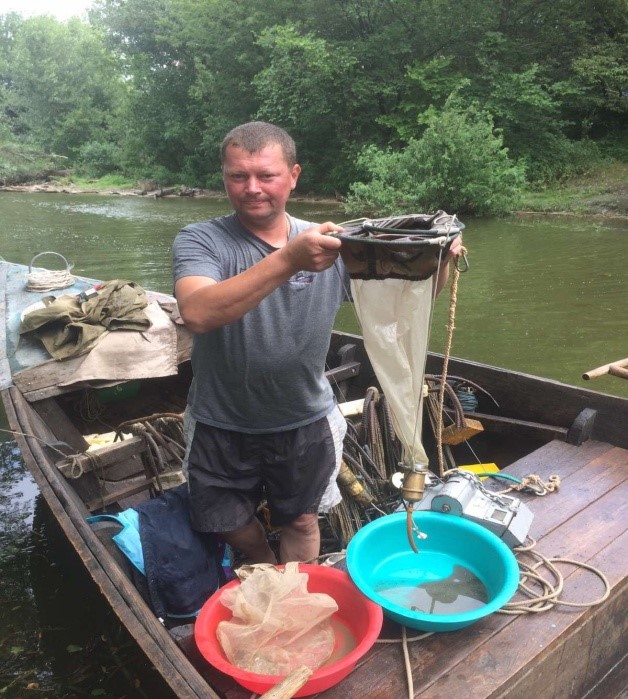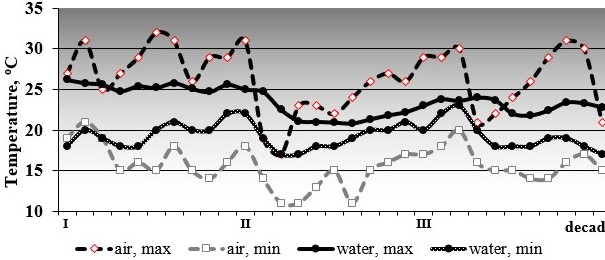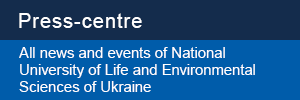Scientists of the Department of Hydrobiology and Ichthyology of NULES study the impact of global warming in the reservoirs of Ukraine
Recently, the deterioration of the ecological situation in reservoirs of various types is associated with global warming and anthropogenic factors. It is manifested through an increase in the average monthly water temperature, a change in the hydrological regime of reservoirs, a decrease in the concentration of dissolved oxygen in the water, an increase in the total mineralization of water, a decrease in the duration of ice. However, rising water temperatures certainly affect the biota of water bodies. According to the literature, the changes will primarily affect prokaryotes and eukaryotes, which control the biogeochemical cycles of water bodies and significantly affect the composition and biomass of freshwater phytoplankton, in particular the dominance of blue-green algae compared to other systematic divisions. Due to such forecasts, monitoring studies of phytoplankton in the Dnipro reservoirs are relevant. The Department of Hydrobiology and Ichthyology conducts monitoring studies of the development of biota of Kremenchug and Kakhovka reservoirs within the project 110/19-pr-2020 "To establish the physiological status of fish in different periods of the annual cycle under global warming and anthropogenic factors"
Researches to study the development of phytoplankton were carried out by methods generally accepted in hydrobiology on three sections of the Kremenchug Reservoir: near the village of Chervona Sloboda (station №1), the village of Lesky (station №2) and the village of Khudyaky (station №3), which are located in the middle section of the Kremenchug Reservoir (Fig. 1).
The peculiarity of this water area is the predominance of floodplains with mostly sandy, occasionally stony soil, they are overgrown and shaded with floating potamogeton (Potamogeton natans L.) and common reed (Phragmites australis (Cav.) Trin. Ex Steud.). There is a lot of shallow water with a depth of 0.5-4.0 m, which is well warmed up.


Figure 1. Sampling of hydrobiological samples
The temperature conditions of the aquatic environment were unstable (Cv = 10.69 – 13.97 %) and stressful for living organisms that inhabited it. The most dangerous were hot sunny days, when the air temperature rose up to 32 oC, and water up to 25.8 oC (Fig. 2).

Figure 2. Dynamics of temperature fluctuations of air and water values by decades in Kremenchug reservoir, August, оС.
Total number of phytoplankton ranged from 13.72 to 67.29 million cells / dm3. Maximum values of 53.97 ± 3.76 million cells /dm3 were registrated in the water area near Chervona Sloboda village, which is located at the top of the study area (Figure 3). A significant decrease in the quantitative values of phytoplankton development was observed downstream. In particular, the area near the village of Lesky was characterized by three times lower numbers as 16.75 ± 1.33 million cells / dm3. Further downstream, in the area near the village of Khudyaki, the total number of phytoplankton was twice lower than at Chervona Sloboda top station and amounted to 26.15 ± 2.09 million cells / dm3.

Figure 3. Distribution of the total number of phytoplankton between its main groups in Kremenchug reservoir, in the lower part of Cherkasy, August, %.
Values of total phytoplankton biomass were minimal 2.30 ± 0.23 mg / dm3 at the sampling site №2 (the village of Leski) and were higher 1.7 times on the two other stations: 4.86 ± 0.36 mg / dm3 on the section №1 of the village of Chervona Sloboda and 4.89 ± 0.39 mg / dm3 in the area of №3 the village of Khudyaki (Figure 4). Such data correspond to the period of decline of algae vegetation of the Kremenchug reservoir – 2.1-3.8 mg / dm3 – in 2004.

Figure 4. The structure of phytoplankton groups in terms of biomass in Kremenchug reservoir downstream from Cherkasy, August, %.
The phytoplankton values of the Kremenchug reservoir were at the level of the total number of 16.8 – 54.0 million cells / dm3, the total biomass of 2.3 – 4.9 mg / dm3 and tended to develop in previous years. The basis of phytoplankton was formed by three groups of algae: Chlorophyta, Bacillariophyta, Cyanophyta.
Blue-green algae (class Cyanophyta) predominated at all sampling stations № 1, 2, 3, amounting to 26.0 – 93.7% and formed the basis of the phytoplankton community. In this group of algae the most represented species were: Aph. flos-aquae, An. flos-aquae, M. aeruginosa, (station № 1 and № 2), An. flos-aquae, M. aeruginosa (station № 3).
Calculation of the Berger-Parker dominance index showed that at all sampling stations the highest rates had only alga M. aeruginosa. Its dominant role gradually decreased along the Dnieper: DBP = 0.83; 0.53; 0.41 at sampling stations № 1, 2, 3, respectively. As a result of intensive development of colonial alga M. aeruginosa, it acquired the status of absolute dominant and subdominant species in the structure of this phytoplanktoсenosis.
Thus, cyanobacteria have become the dominant group of photosynthetic organisms of this phytoplanktocenosis. In such a way occurs the succession of diffuse nature of regressive type towards the monodominance of the community, which threatens the balance of this hydroecosystem in general.
N.Ya. Rudyk-Leuska, M.I. Khyzhniak, M.V. Leuskyi
National University of Life and Environmental Sciences of Ukraine, Kyiv









